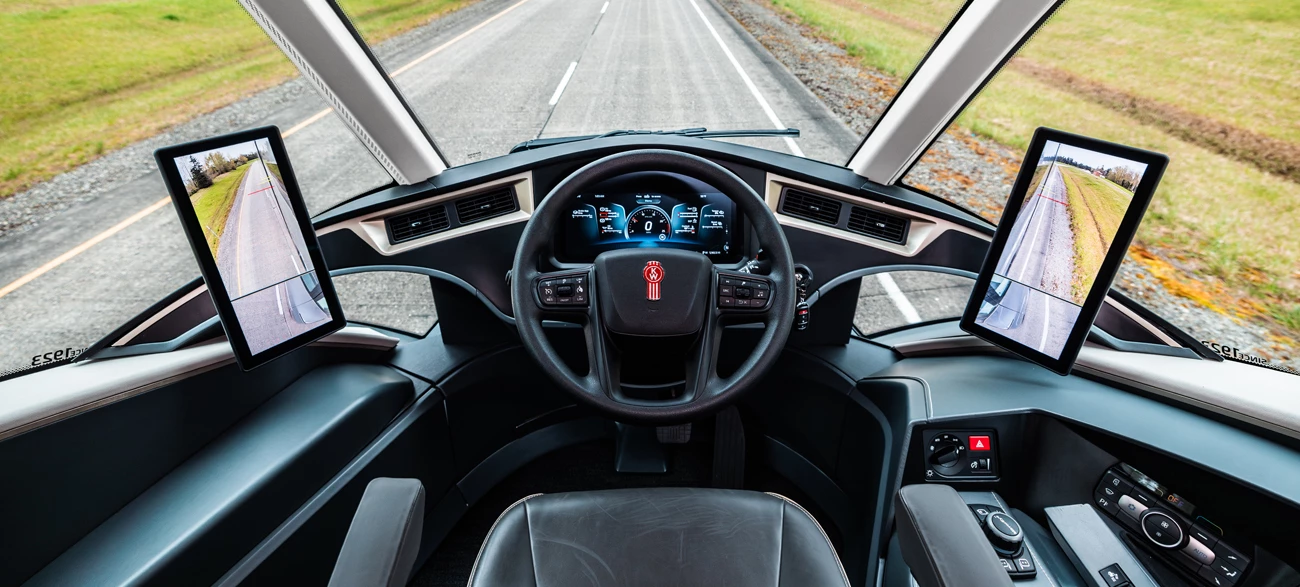Kenworth has unveiled a sleek-looking SuperTruck 2 at the Advanced Clean Transport expo in Las Vegas, attempting to squeeze the maximum possible efficiency out of a diesel powertrain. It works, too, beating the company's most efficient truck by 100%.
It's the result of a six-year project with the US Department of Energy (DoE), in which truck makers have been challenged to improve freight efficiency without dropping diesel as the main energy carrier.
"The goal was a 100% freight efficiency improvement over our 2009 Kenworth T660, which at the time was arguably the most fuel-efficient truck in the industry," says Kenworth GM Jim Walenczak in a press release. "We surpassed the performance of that model to improve efficiency by up to 136%. This was realized through a combination of improving fuel efficiency up to 12.8 mpg (18.4 L/100km) while reducing our combination weight by more than 7,000 pounds (3,175 kg). The result was the ability to haul more payload with an ultra-fuel-efficient tractor-trailer combination."
So what are the key factors here? Well, the aerodynamics have obviously been vastly improved, with a bullet-train-esque design featuring a central cockpit with a panoramic view, a narrowed nose and sloped forehead, as well as low skirts, and wheels fully enclosed within the bodywork. The typical beefy side mirrors have been switched for slim, slippery camera stalks with night vision, and there's variable-height suspension allowing this hauler to get super-low on a nice, smooth highway. The combined result is an astonishing 48% reduction in drag.
Materials and design considerations, along with lightweight, low-rolling-resistance tires, allowed the design team to shave an enormous amount of weight. The SuperTruck 2 tractor and trailer together weigh in at 26,100 lb (11,839 kg), representing an enormous 7,100-lb (3,221-kg) weight saving.
The powertrain is also extraordinary. It combines a PACCAR MX-11-based diesel engine and TX-12 auto transmission with a 48-volt electric generator to create a mild hybrid system that charges its lithium batteries through regenerative braking. This electric system powers the fans, the steering, the coolant, the heating and air-con systems, which would otherwise draw mechanical power straight off the engine – up to 80 horsepower for the engine fans alone, says Kenworth.

In bench testing, this powertrain notched a claimed record with a 55.7% engine efficiency rating.
"Today’s modern diesel engine demonstrates around 47% efficiency," says PACCAR senior engineering manager for advanced technology, Maarten Meijer. "Reaching 55.7% was a major step forward and could only be done by applying new technologies that had not been explored until today. To put that efficiency number into perspective, if this engine were to go into production, it would lead to a 10% fuel efficiency improvement. That’s an astonishing number."
... If it were to go into production.
Which it won't.
"We wanted to push this beyond just a demonstrator truck," says design director Jonathan Duncan. "We wanted to show something dynamic and what the future of Kenworth might look like."

"There are major challenges ahead as we continue to advance vehicle performance, all while keeping in mind the goal to be a carbon neutral society by 2050," adds chief engineer Keith Adams. "This will require tremendous technology changes in the trucking industry and partnering with the DOE on the SuperTruck 2 program was a tremendous opportunity to consider what will be possible as we look toward the future."
The SuperTruck 2 was designed to be powertrain-agnostic, capable of working with battery-electric or hydrogen-fuel-cell-powered drive systems, both of which Kenworth is working on. Mind you, its fuel cell truck is currently a 10-unit pilot program in partnership with Toyota, and its biggest electric vehicle is the T680E, a class-8 cab holding 396 kWh and promising just 150 miles (241 km) of range. That's a ways off the 500-mile (805-km) Tesla Semi.

Still, this DoE project gave Kenworth the time and funding to go back to a clean sheet and design an extreme-efficiency truck from the ground up, and there will certainly be a market appetite for any commercial designs that come out of this. Fuel is no small line item in trucking and logistics, and anything that offers the chance to cut that cost down will find plenty of interest.
Source: Kenworth









